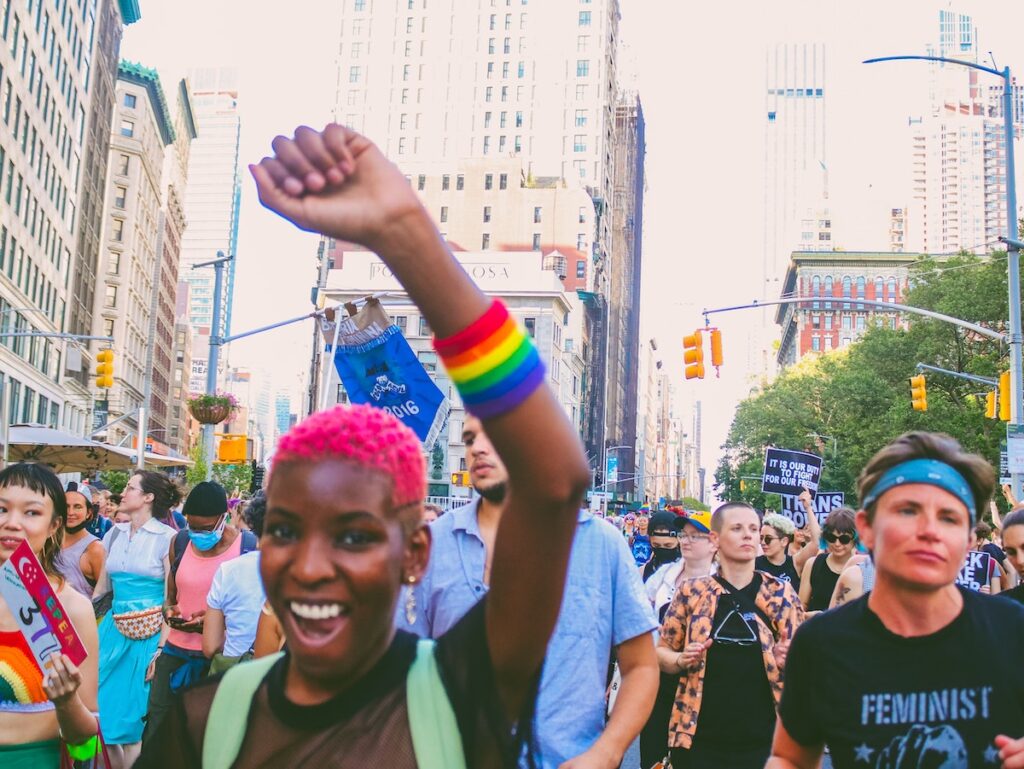
LGBTQ+ youth struggle more with their mental health than their cisgender, heterosexual counterparts (Fulginiti, et al., 2021, Fisher, 2020, Scannapieco, et al., 2018). This is well established among the literature and among mental health practitioners and other helping professionals. And yet, all signs point to queer youth underutilising mental health supports and services either altogether or only seeking them out when in crisis (Ellinghaus, et al., 2021, Wilson, Cariola, 2020).
So why does this remain a consistent problem? How have we tried to address inequities in mental health supports for queer youth? Are our efforts helping or are we still missing the mark?
This blog summarises a recent meta-narrative review (MNR) by McDermott and colleagues (2022) spilling the T (aka – tell the truth) about effective mental health support for queer youth.

Queer youth underutilise mental health services. How can we address inequities in mental health support for LGBTQ+ young people?
Methods
The authors of this meta-narrative review conducted a scoping review of four databases to identify studies relevant to mental health services and supports for LGBTQ+ youth. Interestingly, no other systemic reviews were found during their search, perhaps indicating a gap in our knowledge regarding this topic. The authors chose an MNR methodology because this approach accounts for research from disparate schools of thought while providing a cohesive assessment of the topic (mental health early intervention for LGBTQ+ youth). Specifically, the MNR considers the underlying assumptions from the studies’ theoretical approaches and builds an exploratory narrative using both commonalities and unique contributions from each perspective.
Choosing four constructs – sexual orientation and gender identity (SOGI), age, mental health, and intervention – the authors searched relevant databases and considered other input such as expert informants, manually searching journals, following citations from included studies, and online searches by invested parties. Each article found by these methods were subject to the review process.
Two authors sorted through the articles using the Population, Intervention, Comparison, Outcome (PICO) framework for inclusion/exclusion (p. 2). Consequentially, articles older than 1990 were excluded, “youth” was defined as under 26 years old, and other exclusion/inclusion criteria were established. Following this, the authors established a quality appraisal tool using the EPPI-Centre ‘Weight of Evidence’ framework (p. 3).
Following the quality appraisal, research team members conducted a two-stage synthesis of the papers to map a narrative response to the question ‘what are the implications of the contested concepts for developing early intervention mental health support for LGBTQ+ youth?’ (p. 3).
Results
Eighty-eight papers were included in the analysis after screening 2,951 titles and abstracts and 200 full papers for inclusion/exclusion criteria and quality control. In Stage 1 of the meta-narrative review, 3 schools of thought were identified: psychology, psycho-social, and social/youth work.
Psychology articles focused on identifying mental distress and relied heavily on Meyer’s (2003) Minority Stress Framework. Assisting individual youth to modify their cognitions was the main support considered in most of these studies.
Articles using a Psycho-Social approach tended to incorporate a social context (ex: school or community centre) regarding mental health supports for LGBT youth compared to the psychology perspective. However, the constructs of youth, mental health, and development still tended toward more heteronormative and individualistic interpretations.
The social/youth-work meta-narrative was more likely to contextualise the mental health needs of LGBT youth within a larger system and less likely to consider LGBT youth as a homogenous group than the other two perspectives. Social/Youth work articles were likely to utilise a qualitative approach, in collaboration with community programs and garnering the youth’s input as opposed to qualitative data drawn from adult input.
The resulting synthesis of these three meta-narratives produced a multisystemic view of the youth, mental health, and mental health disparity (between LGBT and het-cis youth) constructs. The authors depict this synthesis as four concentric rings – macro, meso, micro and subjective/individual influences on ‘successfully’ supporting LGBT youth at an early stage of mental health symptoms. Themes emerging for each level:
- Macro: bio-psychological power, cis-heteronormativity, intersectionality,
- Meso: safety, belonging, recognition,
- Micro: agency, autonomy, resistance,
- Subjective/Individual: emotions, subjective mental health, distress,

Intervention to improve LGBTQ+ youth mental health is best started from an earlier point than when the youth demonstrate mental health struggles.
Conclusions
The authors posit the subjective perspective of LGBT youth’s own mental health should be enough to warrant access to supports. A mental health diagnosis should not be necessary to access social support and the earlier in their struggles an LGBT youth is supported the more likely they will be to have better outcomes.
The meta-narrative review demonstrates the heavy influence of legal, policy, academic and social notions on the study and interpretation of supporting the mental health of LGBT youth. The authors observe the schools of thought (psychology, social work, public health, sociology, etc.) regarding LGBT youth remaining siloed from each other has exacerbated the problem of higher rates of mental health distress compared to those of cis-het youth.

LGBTQ+ youth mental health lived experience should be enough for appropriate access to psychological interventions and support without a diagnosis.
Strengths and limitations
The authors acknowledge language and the use of Population, Intervention, Comparison, Outcome (PICO) framework for inclusion and exclusion criteria as limitations of the study. They also point out that this study proposes a theoretical framework that now needs to be tested empirically before being applied.
This significant contribution to a widely accepted but misunderstood social issue is one of this study’s strengths. Additionally, the author’s use of an established, theory-led methodology increases the confidence in their findings.
It is likely that the authors agree with anyone involved in providing support for LGBTQ+ youth that intervention is better the sooner it is implemented. A strength I note in this study is the inclusion of multiple perspectives leading to a cohesive model. This articulation can assist LGBTQ+ youth and their supports to advocate for improved policy and funding of programs that fall outside of the medical/mental health field.

Multiple perspectives are discussed in this study on both prevention and treatment that can be useful for LGBTQ+ youth with mental health difficulties.
Implications for practice
The authors bring several new perspectives to the concern of disproportionate mental health concerns among LGBT youth compared to their heterosexual, cisgender peers. Providing mental health support prior to LGBT youth having a diagnosable mental health concern and considering the youth’s subjective experiences of their own wellbeing are significant implications to the current understanding of the majority of services addressing mental health concerns for LGBT youth.
Those of us who are involved in supporting LGBTQ+ youth are likely to have an intuitive sense of these findings. The authors provide evidence supporting their intuition. Where support systems are often derailed is in securing funding to apply this knowledge. It is difficult to leverage one’s intuition when advocating for funding and prior authorisation for services when LGBTQ+ youth mental illness is so often overlooked until it is too late. By strengthening the evidence base on early intervention and support, we can decrease the disparity in positive mental health outcomes for LGBTQ+ youth, when compared to their heterosexual/cisgender counterparts.

In-depth understanding of queer youth’s subjective experiences can lead to service evaluation and quality improvement in the care provided to this community.
Statement of interests
This writer has no conflicts of interest to report.
Links
Primary paper
McDermott, ES, Eastham, R, Hughes, E, Pattinson, E, Johnson, K, Davis, S, Pryjmachuk, S, Mateus, MDCC & Jenzen, O 2021, ‘Explaining effective mental health support for LGBTQ+ youth: A meta-narrative review’, SSM – Mental Health. https://doi.org/10.1016/j.ssmmh.2021.100004
Other references
Alessi, E. J. (2014). A framework for incorporating minority stress theory into treatment with sexual minority clients. Journal of Gay & Lesbian Mental Health, 18(1), 47-66.
Ellinghaus, C., Truss, K., Liao Siling, J., Phillips, L., Eastwood, O., Medrano, C., & Bendall, S. (2021). “I’m tired of being pulled from pillar to post”: A qualitative analysis of barriers to mental health care for trauma‐exposed young people. Early intervention in psychiatry, 15(1), 113-122.
Fish, J. N. (2020). Future directions in understanding and addressing mental health among LGBTQ youth. Journal of Clinical Child & Adolescent Psychology, 49(6), 943-956.
Fulginiti, A., Rhoades, H., Mamey, M. R., Klemmer, C., Srivastava, A., Weskamp, G., & Goldbach, J. T. (2021). Sexual minority stress, mental health symptoms, and suicidality among LGBTQ youth accessing crisis services. Journal of youth and adolescence, 50(5), 893-905.
Meyer, I. H. (2003). Prejudice as stress: Conceptual and measurement problems. American Journal of Public Health, 93(2), 262-265.
Scannapieco, M., Painter, K. R., & Blau, G. (2018). A comparison of LGBTQ youth and heterosexual youth in the child welfare system: Mental health and substance abuse occurrence and outcomes. Children and Youth Services Review, 91, 39-46.
Wilson, C., & Cariola, L. A. (2020). LGBTQI+ youth and mental health: a systematic review of qualitative research. Adolescent Research Review, 5(2), 187-211.
Photo credits
- Photo by Steve Johnson on Unsplash
- Photo by Jakayla Toney on Unsplash
- Photo by Anna Selle on Unsplash
- Photo by Stanley Dai on Unsplash
- Photo by Towfiqu barbhuiya on Unsplash
